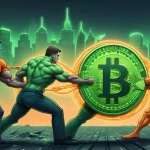Philippines Gears Up for ASEAN 2026: Web3 and Crypto Take Center Stage

Philippines Sets the Stage for ASEAN 2026: A Bold Web3 Push with Crypto in Focus
The Philippines is gearing up to host the 44th ASEAN Summit in 2026, and it’s not just another diplomatic gathering. This event is poised to be a defining moment for Web3 and cryptocurrency adoption in Southeast Asia, with President Marcos Jr. and Trade Secretary Cristina Roque aiming to showcase the nation’s digital prowess on a global stage. Add to that a high-profile invitation to U.S. President Donald Trump—a known crypto advocate—and the spotlight could burn even brighter. Alongside this, whispers of emerging crypto projects are stirring speculative buzz, but with opportunity comes caution in this volatile space.
- Web3 Leadership Ambition: Philippines to position itself as a regional crypto hub at ASEAN 2026.
- Geopolitical Boost: Trump’s potential attendance could amplify global crypto interest.
- Speculative Plays: Tokens like Snorter Token ($SNORT), TOKEN6900 ($T6900), and OpenServ ($SERV) pitched as early bets.
Philippines as a Web3 Trailblazer
With over 7,600 islands, the Philippines faces unique challenges in connectivity and economic inclusion, but it’s turning those hurdles into opportunities through blockchain and digital innovation. Ranking 20th globally in crypto wealth, the nation has embraced decentralized technologies with fervor, from blockchain-based gaming to digital payments. The 2026 ASEAN Summit—short for Association of Southeast Asian Nations, a regional bloc of 10 countries promoting economic and political cooperation—offers a platform to flaunt this progress. Under the “Bagong Pilipinas” initiative, which translates to “New Philippines,” the government is pushing digital transformation to bridge geographical divides and empower micro, small, and medium enterprises (MSMEs). Trade Secretary Cristina Roque has been vocal about this vision, stating the need to demonstrate tech advancements to ASEAN neighbors and beyond, as highlighted in official announcements.
This resonates deeply with the ethos of decentralization that Bitcoin champions—freedom from centralized control and financial sovereignty for the masses. Picture a fisherman in a remote barangay (a local administrative village) accessing global markets through a blockchain payment system. That’s the kind of disruption we’re rooting for, the kind that Bitcoin maximalists see as the ultimate goal. Yet, let’s not get carried away. Implementation isn’t a walk in the park—regulatory gray areas, infrastructure gaps, and the risk of overhype around events like ASEAN 2026 could dampen the impact. It’s one thing to wave the Web3 flag; it’s another to deliver results, a topic widely discussed in online communities.
Geopolitical Catalyst: Trump and ASEAN 2026
The stakes get even higher with the geopolitical angles at play. The summit coincides with the 80th anniversary of U.S.-Philippine diplomatic ties and the 75th anniversary of their Mutual Defense Treaty, adding symbolic weight to the event. President Marcos Jr. is leveraging this milestone by personally inviting Donald Trump, whose recent pro-crypto stance has caught global attention. Marcos Jr. highlighted the significance of this potential visit:
“I look forward to hosting President Trump next year to attend the ASEAN meetings under the Philippines’ chair, which also coincides with the commemoration of our 80th year of diplomatic ties and 75 years of the Mutual Defense Treaty.”
Trump’s crypto-friendly policies—think reduced regulatory oversight, proposals for Bitcoin as a reserve currency, and even a crypto advisory council—could turn his attendance into a lightning rod for mainstream adoption. Southeast Asia, with its high smartphone penetration and significant unbanked population (estimates suggest over 70% lack traditional banking access in some areas), is a ripe market for blockchain’s promise of inclusivity. If Trump shows up, expect a surge of investor interest in the region’s crypto landscape, potentially accelerating projects and policies alike, as explored in discussions on his stance impacting the region.
But let’s pump the brakes. His attendance isn’t confirmed, and ASEAN itself often draws flak for being more of a symbolic talk shop than a body with real enforcement power. Critics argue that past summits have produced lofty promises on tech and finance with little follow-through, like sluggish progress on regional digital payment systems. Will 2026 be different, or just another round of photo ops with buzzwords like “blockchain” thrown around? That’s a question we need to keep front and center, with some insights available on how his policies might influence events like ASEAN 2026.
Local Impact of Blockchain Innovation
Digging into the Philippines’ crypto credentials, their early adoption stands out. Blockchain gaming, led by projects like Axie Infinity, has turned play-to-earn models into livelihoods for thousands, especially during economic downturns. Digital payments and remittance solutions using crypto are also gaining traction, addressing the high costs and delays of traditional systems—a key pain point for a nation reliant on overseas workers sending money home. Bitcoin, as the purest form of decentralized money, fits perfectly here, offering a store of value and transaction medium outside the grip of banks or governments. This aligns with our belief in financial sovereignty, the kind of empowerment that centralized systems have failed to deliver.
For MSMEs, blockchain offers tools to overcome fragmentation across islands—think smart contracts for supply chain transparency or tokenized crowdfunding for capital access. These aren’t hypotheticals; they’re happening in pockets of the country right now. The ASEAN Summit could amplify these efforts by drawing global attention and investment. Still, challenges loom large. Scalability issues, energy costs for blockchain networks, and a patchwork of local regulations could stall progress if not addressed. Hype alone won’t cut it—execution is everything, and further exploration of these developments can be found in relevant case studies.
Regional Crypto Regulation Landscape
Regulation remains a wildcard in the Philippines and across Southeast Asia. The Bangko Sentral ng Pilipinas (BSP), the nation’s central bank, has taken steps to recognize digital assets, issuing guidelines for virtual asset service providers since 2017. However, the framework is still evolving, balancing innovation with consumer protection. Across ASEAN, there’s a lack of harmonization—Thailand pushes crypto tourism, while countries like Vietnam remain cautious with outright bans on crypto as payment. The 2026 Summit could be a chance to align policies, creating a cohesive regional stance that attracts investment without opening the door to scams. For more background on the summit’s role, check out this resource on ASEAN 2026 in the Philippines.
Yet, history suggests caution. ASEAN’s track record on enforcing unified financial or tech policies is spotty at best, often leaving member states to chart their own paths. Overregulation risks stifling innovation, while underregulation invites fraud—look no further than the countless rug pulls in loosely governed markets. The Philippines must navigate this tightrope, and while the summit offers a stage, tangible policy shifts are far from guaranteed. For Bitcoin advocates, the ideal remains minimal interference; let the tech speak for itself through adoption, not mandates.
Speculative Crypto Hype: Boom or Bust?
Now, let’s tackle the speculative side of this narrative—three crypto projects pitched as potential breakout stars ahead of the ASEAN-driven hype cycle. Before diving in, a word of warning: the crypto space is a minefield of scams and broken promises. If someone’s screaming “guaranteed 10x gains,” they’re likely peddling snake oil. Let’s break these down with a clear head, tying them to the kind of buzz major events like the summit can generate, while keeping skepticism dialed to eleven.
- Snorter Token ($SNORT): Tied to a Telegram trading bot launching on Solana, with plans to expand to Ethereum, BNB Chain, Polygon, and Base. It promises MEV-protected swaps—meaning protection from miner extractable value, where miners manipulate transaction order for profit at users’ expense—and low fees at 0.85%. Presale price sits at $0.1005, with wild projections of hitting $1.92 by 2026. Sounds slick, but trading bots are a gamble. Real-world flops, like a user losing 2 SOL on a similar Solana bot, show how often these tools buckle under pressure or hide shady mechanics. Team anonymity and lack of proven traction are red flags. Tread with extreme caution, and for deeper insights, see community feedback on similar bots.
- TOKEN6900 ($T6900): An Ethereum-based meme coin with no utility, riding purely on community hype and humor. It takes a satirical jab at competitors like SPX6900 by offering “1x better” with an extra token in supply. Having raised over $1.6 million in presale at $0.00685 per token, it’s audited by Coinsult and SolidProof as low risk. Meme coins can skyrocket—Dogecoin proved that—but they crash just as fast. Think of this as a lottery ticket in a hurricane: thrilling, but don’t bet your savings on it.
- OpenServ ($SERV): A utility token for an AI-driven ecosystem automating workflows across Web2 and Web3, using AI agents to streamline decentralized apps or business operations. It’s surged 63% recently, with a 30% user base increase, trading at $0.05948 on exchanges like MEXC as its mainnet launch nears. Of the trio, this has the most tangible use case, blending blockchain with AI—a combo with real potential. Still, early-stage projects often overpromise, and a price pump doesn’t equal sustainability. Dig into their whitepaper and team credentials before even considering a position.
Events like ASEAN 2026 can spark waves of speculative interest, especially if high-profile figures like Trump amplify the narrative. But let’s be real—these tokens are high-risk plays at best. Bitcoin remains my north star, the unassailable king of financial sovereignty, but I’ll concede that altcoins and protocols on networks like Ethereum or Solana fill niches Bitcoin doesn’t touch. $SERV’s AI integration, for instance, hints at blockchain as infrastructure beyond just money. That said, the dark side of crypto—scams, rug pulls, blind hype—looms large with unproven projects like $SNORT and $T6900. I’m all for effective accelerationism, pushing tech forward fast, but not at the cost of reason or your wallet. For a closer look at emerging tokens tied to this event, explore new projects gaining traction.
Key Takeaways and Questions to Ponder
- What’s the significance of the Philippines hosting ASEAN 2026 for crypto?
It’s a chance to cement the country as a Web3 and crypto leader in Southeast Asia, spotlighting digital innovation when regional adoption is accelerating. - How could Trump’s attendance influence the crypto landscape?
His pro-crypto policies, like reduced regulation and Bitcoin as a reserve asset, could draw massive global investor focus to the region—if he attends, which isn’t confirmed. - Are Snorter Token ($SNORT), TOKEN6900 ($T6900), and OpenServ ($SERV) worth investing in?
They’re highly speculative; $SERV offers some utility with AI, but $SNORT and $T6900 scream high risk. Do your own research—thoroughly—before even glancing at them. - Will ASEAN 2026 drive real policy changes for crypto in the region?
It’s uncertain; while it can raise awareness, ASEAN’s history of limited enforcement power suggests tangible outcomes aren’t a given. - How does this tie to Bitcoin’s mission of decentralization?
The Philippines’ focus on financial inclusion through blockchain echoes Bitcoin’s core ethos of empowerment, though speculative altcoins often stray from that purity.
The Philippines is rolling the dice with ASEAN 2026, aiming to establish itself as a crypto-friendly powerhouse in Southeast Asia, potentially turbocharged by a Trump cameo. Whether this translates to lasting progress or just fleeting buzz hinges on execution and policy grit. Bitcoin remains the ultimate tool for financial freedom in my book, but the broader blockchain space—from AI utilities to trading bots—has a role in this revolution, provided it’s not drowned out by scams. As for the hyped tokens, innovation deserves a fair shake, but shillers and unproven promises get no pass. Stay sharp, dig deep into any investment, and let’s see if 2026 marks the decentralized turning point we’re all hungry for—or just another chapter of unfulfilled hype.



